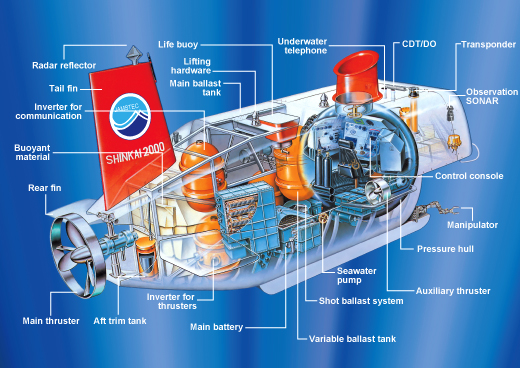SHINKAI 2000
Deep Submergence Research Vehicle SHINKAI 2000 retired on March, 2004.
Overview
SHINKAI 2000 is a manned research submersible that can dive to depths of 2,000 meters. SHINKAI 2000 was constructed in 1981 as Japan's first full-fledged manned submersible for deep-sea research, and since then, it had been on the front line of marine surveys for years.
SHINKAI 2000 dived in various oceans (mainly the sea around Japan) and contributed significantly to the progress of deep-sea research in Japan, including the discovery of chemosynthetic Calyptogena colonies off Hatsushima Island in the Sagami Bay, and the discovery of hydrothermal venting phenomena in the Okinawa Trough. The accumulated technologies and experiences in development and construction of SHINKAI 2000 have been applied to development of SHINKAI 6500, KAIKO, and other marine survey equipment.
After playing a huge role in the rapid progress of deep-sea research in Japan for more than two decades, SHINKAI 2000 finished its last and 1,411th dive on November 11, 2002, and retired afterward.
Mission
- Explore marine mineral resources
SHINKAI 2000 explored petroleum, natural gas, manganese nodules, phosphorite and other mineral deposits.
- Explore deep-sea marine resources
SHINKAI 2000 explored untapped deep-sea marine resources including Macrouroidinae species.
- Examine conditions of marine structures
SHINKAI 2000 examined the conditions of installed submarine cables.
- Conduct physical oceanography research
SHINKAI 2000 conducted research on water temperature, salinity, current direction, and current velocity in the sea which are closely linked to shipping, weather, and fishing.
- Conduct geophysics research
SHINKAI 2000 conducted research on seafloor topography, seafloor structure, gravity, and magnetic force which were helpful for earthquake prediction.
Systems

Principal specifications
History of SHINKAI 2000
- 2004Retired at the end of March 2004.
- 2002Made the last and 1,411th dive on November 11, 2002.
- 1998Achieved milestone 1,000th dive. Dived at the depth of 1,027 meters off the coast of Iheya, Nansei Islands.
- 1994Found deep-sea tube worms, Lamellibrachia satsuma, in shallow water (82 meters deep) off Kagoshima Bay - shallower than any other tube worms that had been found.
- 1993Discovered sand boiling, earth fissures and cracks on seafloor when diving off Okushiri Island after the Hokkaido-Nansei-Oki Earthquake. Observed that many benthic organisms were buried or swept down due to mudslides.
- 1992Discovered, extracted and cultured highly-effective oil-degrading bacteria in seafloor mud of Suruga Bay.
- 1991SHINKAI 6500 started research dives.
- 1990Sampled tube worms and vesicomyid clams (Calyptogena soyoae) from a community of the clams off Hatsushima Island in the Sagami Trough. Deep-sea microbes were extracted from them and cultured subsequently on land.
Achieved milestone 500th dive. Dived at the depth of 1,624 meters in the Okushiri Ridge, the Sea of Japan. - 1989Found for the first time carbon dioxide hydrate in the Izena cauldron, Okinawa Trough. It is a highly unusual phenomenon where liquefied CO2-rich bubbles are released from some white spots on the seafloor. Discovered a black smoker vent at the depth of 1,340 meters in the Izena cauldron, Okinawa Trough for the first time in Japan.
- 1988Succeeded on the test of the underwater video transfer system. The system used acoustic signals and transferred a still image taken by SHINKAI 2000's video camera to the support vessel in 46 seconds.
- 1985Discovered deep-sea tube worms off the coast of Shikoku.
Discovered garbage and landslide sediment in Sagami Bay. - 1984Discovered pillow lava at the depth of 1,270 meters off the east coast of Atagawa in the Izu Peninsula.
Discovered a colony of Calyptogena soyoae at the depth of 1,100 meters off Hatsushima Island in the Sagami Trough. - 1983Started research dives on July 22, 1983. The first dive was in 80 meter-deep water in Toyama Bay.
- 1981Launched at Mitsubishi Heavy Industries' Kobe Shipyard. A ceremony to celebrate the commissioning of SHINKAI 2000 and its support vessel NATSUSHIMA was held at Harumi, Tokyo in the presence of Crown Prince Hironomiya.